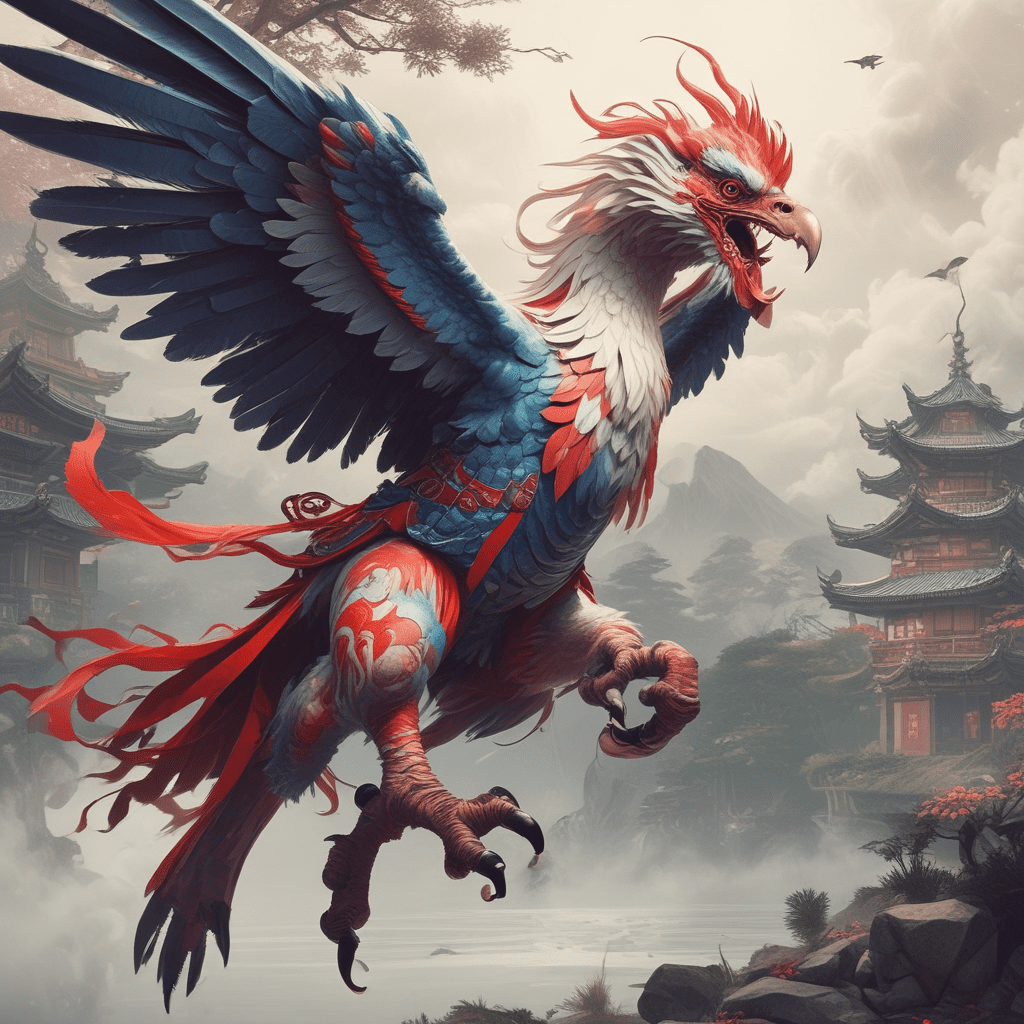The Enchanting World of Thai Air Folklore: A Realm of Myths and Legends
The skies above Thailand have long held a special significance in Thai culture and folklore, inspiring stories of mythical creatures that embody the power, mystery, and beauty of the heavens. These legendary beings, often depicted in intricate temple carvings and traditional art, serve as reminders of the mystical heritage of Thai people and the deep connection between humanity and the natural world. From the serpentine Naga to the majestic Garuda, these captivating creatures have captivated the imaginations of generations, weaving a tapestry of myths and legends that continue to be passed down through the ages.
Guardians of the Skies: Mythical Creatures of Thai Air Folklore
Thailand's air folklore is rich with captivating creatures that inhabit the skies, embodying the power, mystery, and beauty of the heavens. These mythical beings, often depicted in intricate temple carvings and traditional art, play important roles in Thai stories and legends, representing various forces of nature and serving as protectors and guardians of the realm. From the serpentine Naga, who commands the waters and the skies, to the divine Garuda, the powerful bird that symbolizes strength and resilience, these creatures have captivated the imaginations of generations, weaving a tapestry of myths and legends that continue to be passed down through the ages.
Naga: Serpentine Deities of the Skies and Waters
In the realm of Thai air folklore, the Naga stands as a powerful and enigmatic creature, embodying both the grace of a serpent and the wisdom of a deity. These serpentine beings are often depicted with multiple heads, scales that shimmer with iridescent colors, and a majestic mane. Legend has it that Nagas reside in celestial palaces beneath the earth, emerging from the waters to perform feats of magic and protect the world from harm. Their presence is closely linked to rain and water, and they are said to control the flow of rivers and the bounty of the land. In some tales, Nagas are described as guardians of treasures and keepers of ancient knowledge, while in others, they are depicted as benevolent protectors of humanity, offering guidance and protection to those who seek their favor.
The Naga is a frequent motif in Thai art and architecture, appearing in intricately carved sculptures on temple walls and in ornate murals depicting scenes from Hindu mythology. These depictions often showcase the Naga's power and majesty, serving as a reminder of the profound influence this mythical being has had on Thai culture.
Garuda: The Divine Bird of Power and Strength
As a symbol of strength, resilience, and divine power, the Garuda holds a prominent place in Thai air folklore. This majestic bird, often depicted with a human-like face, golden wings, and sharp claws, is said to be the king of all birds and a powerful figure in Hindu mythology. In Thai mythology, Garuda is revered as a protector of Buddhism, often portrayed carrying a Buddha statue or flying above temples, symbolizing the triumph of good over evil. Garuda's ability to fly above the clouds and pierce the heavens with its gaze represents the power of spiritual enlightenment and the ability to overcome worldly limitations.
Garuda's legend is intertwined with the story of the Naga, with the two often depicted in an eternal struggle for dominance. This rivalry symbolizes the ongoing battle between good and evil, the forces of nature, and the pursuit of spiritual enlightenment.
Kinnaree: Half-Human, Half-Bird Enchantresses of the Forest
The Kinnaree, a captivating creature that embodies the fusion of human grace and avian beauty, is a prominent figure in Thai air folklore. These enchanting beings, often depicted with the upper body of a woman and the lower body of a bird, are said to inhabit the forests and mountains of Thailand, where they possess magical abilities and beguiling voices. Their beauty and grace are said to be irresistible, and their songs can captivate even the most hardened hearts.
Kinnaree are often associated with music, dance, and the arts, and their presence is believed to bring good luck and prosperity. In some tales, they are portrayed as protectors of the forest and guardians of ancient knowledge, while in others, they are presented as mischievous and playful beings who delight in tricking humans.
Theories on the Origin of Thai Air Folklore
The captivating stories of mythical creatures in Thai air folklore likely originated from a blend of influences, reflecting the rich cultural tapestry of the nation. These theories, while often intertwined and complementary, offer valuable insights into the development of these fascinating legends.
Influence of Hinduism and Buddhism
The arrival of Hinduism and Buddhism in Thailand, starting around the 1st century CE, significantly shaped Thai culture and its mythology. These religions introduced powerful deities, epic narratives, and intricate cosmology, which became woven into existing beliefs and traditions. The Naga, for instance, is deeply rooted in Hindu mythology, while the Garuda, with its association with Vishnu, also draws heavily from this religious tradition.
The influence of Buddhism, particularly Theravada Buddhism, further enriched Thai folklore. The emphasis on karma, rebirth, and the cyclical nature of existence resonated with ancient animistic beliefs, forging a unique brand of spirituality deeply intertwined with nature.
Ancient Animistic Beliefs and Nature Worship
Long before the arrival of Hinduism and Buddhism, the people of Thailand held a deep reverence for nature, attributing spiritual significance to the elements and the natural world. This animistic belief system, which venerates spirits and deities associated with specific places, objects, or natural phenomena, likely played a crucial role in shaping the early forms of Thai air folklore.
The reverence for mountains, forests, and the vastness of the sky inspired tales of supernatural beings associated with these elements. The Kinnaree, with its connections to music and the forest, exemplifies this connection between nature and the supernatural, reflecting a belief in the power and mystery of the natural world.
Connection to the Power and Mystery of the Skies
The skies above Thailand have always held a sense of wonder and mystery, prompting generations to look up and marvel at the celestial wonders. The vast expanse of the sky, the awe-inspiring power of storms, and the radiant beauty of sunsets and starlit nights all contributed to a profound sense of the supernatural.
This fascination with the heavens likely fueled the creation of mythical creatures like the Garuda, a majestic bird capable of soaring above the clouds and navigating the celestial realm. The association of Nagas with rain and weather also suggests a deep connection between the skies and the supernatural, reflecting the power and mystery attributed to the elements.
The Role of Air Folklore in Thai Culture and Society
Thai air folklore serves as a vital thread in the rich tapestry of Thai culture, contributing to the nation's identity, values, and social fabric. These mythical tales are not merely entertaining stories but profound expressions of belief, wisdom, and cultural heritage.
Preservation of Cultural Heritage and Identity
Air folklore serves as a repository of cultural memories, preserving ancient knowledge, beliefs, and values that have been passed down through generations. These mythical creatures, with their stories and symbolism, embody the essence of Thai culture, reminding people of their roots and heritage.
The intricate depictions of Garuda, Naga, and other mythical creatures in temples, murals, and traditional art serve as tangible reminders of this rich heritage, ensuring that these stories and their symbolic meanings remain alive and relevant.
Reflection of Values and Morality
The characters and narratives in Thai air folklore often reflect the moral values and beliefs central to Thai society. The Garuda represents strength, wisdom, and divine power, embodying the ideals of righteousness and justice. The Naga, with its connection to the natural world and its ability to summon rain and control the waters, symbolizes the importance of respecting the environment and living in harmony with nature.
These mythical stories serve as cautionary tales, teaching lessons about the consequences of actions, the importance of ethical behavior, and the need to maintain balance in the world.
Inspiration for Art, Literature, and Performance
Thai air folklore has profoundly influenced the artistic and cultural expressions of the nation, serving as a source of inspiration for countless works of art, literature, and performance. The mythical creatures, with their captivating forms and compelling stories, have been immortalized in traditional dance, theatre, and music, adding a layer of cultural richness and symbolism to these art forms.
The enduring presence of these creatures in contemporary art, literature, and film testifies to the enduring power and influence of Thai air folklore in shaping the nation's cultural landscape.
Frequently Asked Questions
What is the most popular mythical creature in Thai air folklore?
The Naga, with its serpentine form, association with water and rain, and its frequent depictions in art and architecture, is considered one of the most popular and influential creatures in Thai air folklore.
How are these creatures depicted in Thai art?
Mythical creatures like the Garuda, Naga, and Kinnaree are often intricately carved in temple walls, depicted in ornate murals, and featured in traditional paintings and sculptures, reflecting their significance in Thai culture and religion.
Do Thai people still believe in these mythical creatures?
While some aspects of superstition and belief in the supernatural persist, modern Thai society views these creatures primarily as symbols of cultural heritage, folklore, and artistic inspiration. However, their enduring presence in art, literature, and popular culture continues to reflect their deep-rooted influence on the national identity and imagination.
Are there any modern interpretations of these creatures?
Modern Thai artists, writers, and filmmakers often reinterpret these mythical creatures, incorporating them into contemporary narratives and artistic expressions, blending traditional lore with modern themes and perspectives. This blending of traditional and contemporary elements helps keep these captivating creatures relevant and engaging to new generations.
How can I learn more about Thai air folklore?
You can explore Thai air folklore by visiting temples and museums, researching online resources, reading books on Thai mythology, and engaging with modern interpretations of these creatures in contemporary art, literature, and film.



